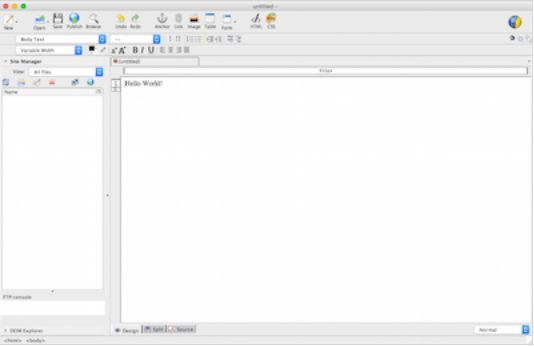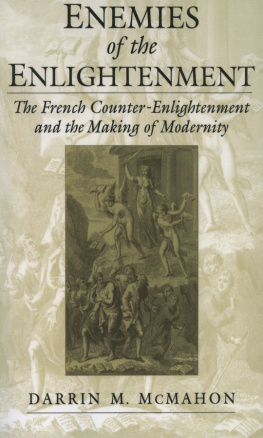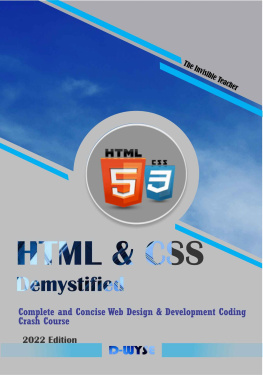McMahon - HTML & CSS Crash Course: Learn html and css with easy to follow-step-by-step tutorials
Here you can read online McMahon - HTML & CSS Crash Course: Learn html and css with easy to follow-step-by-step tutorials full text of the book (entire story) in english for free. Download pdf and epub, get meaning, cover and reviews about this ebook. year: 2015, publisher: Bluewater Publishing LLC, genre: Home and family. Description of the work, (preface) as well as reviews are available. Best literature library LitArk.com created for fans of good reading and offers a wide selection of genres:
Romance novel
Science fiction
Adventure
Detective
Science
History
Home and family
Prose
Art
Politics
Computer
Non-fiction
Religion
Business
Children
Humor
Choose a favorite category and find really read worthwhile books. Enjoy immersion in the world of imagination, feel the emotions of the characters or learn something new for yourself, make an fascinating discovery.

- Book:HTML & CSS Crash Course: Learn html and css with easy to follow-step-by-step tutorials
- Author:
- Publisher:Bluewater Publishing LLC
- Genre:
- Year:2015
- Rating:4 / 5
- Favourites:Add to favourites
- Your mark:
- 80
- 1
- 2
- 3
- 4
- 5
HTML & CSS Crash Course: Learn html and css with easy to follow-step-by-step tutorials: summary, description and annotation
We offer to read an annotation, description, summary or preface (depends on what the author of the book "HTML & CSS Crash Course: Learn html and css with easy to follow-step-by-step tutorials" wrote himself). If you haven't found the necessary information about the book — write in the comments, we will try to find it.
HTML & CSS Crash Course: Learn html and css with easy to follow-step-by-step tutorials — read online for free the complete book (whole text) full work
Below is the text of the book, divided by pages. System saving the place of the last page read, allows you to conveniently read the book "HTML & CSS Crash Course: Learn html and css with easy to follow-step-by-step tutorials" online for free, without having to search again every time where you left off. Put a bookmark, and you can go to the page where you finished reading at any time.
Font size:
Interval:
Bookmark:
However if you are a Mac user I'm going to recommend a special HTML editor which is free called Kompozer. The nice thing about Kompozer is that it allows you to preview your file in real time inside the application without having to save your html file and loading it in a browser. Although in this book we will be focusing on teaching HTML and CSS, Kompozer allows WYSWYG editing of web pages. You can download it free here: http://www.kompozer.net/ A website is made up of multiple HTML pages. So each HTML file is a single web page. When you type in a websites home address, such as http://cnn.com or http://nytimes.com, what happens is the browser opens a special file named index.html.
In a nutshell this is an html file no different than any other, but it has the name index that tells the broswer to load this file when someone visits the website. On your server you will place the index.html file in the home directory. There are some exceptions to this but for now that is how you can view the home page of a website. The other web pages on the site will have different names pageone.html, pagetwo.html etc. These other pages can be in the home directory or you can make a folder on your server and place the pages in there. So for example, suppose you have a website http://acmeincorporated.com.
In the public_html folder on the server, you would place the home page here. This would be the file index.html. You could place an about.html page in this folder as well. Then it would be referenced in the browser as: http://acmeincorporated.com/about.html Alternatively, you could create a folder in your home directory and place the about.html file in there. Lets say that we called that folder info. In that case, the web address would be: http://acmeincorporated.com/info/about.html Like a word processing document, an HTML file can include different fonts, colors, images, and links to other html pages.
An HTML page can also have a style format which is done using CSS. We will see how to enter the appropriate codes to do these tasks in future chapters. Your First Webpage Now that we have an idea of what a web page and HTML file is and how to create one, let's get our feet wet and start creating simple web pages. The first thing you need to know is how to give instructions to the browser. This is done by using tags. The format used to enter a tag is to enclose it in <>.
You will need an opening tag and a closing tag. Inside the <> characters, you give the browser and instruction. So for illustration, to tell the browser that a block of text is tag_one, the opening tag would be: A closing tag is indicated with a forward slash /. So to tell the browser that we are finished with tag_one, we would write: Now let's get into the structure of an actual HTML document and real tags that are used. The first line in your file is this one: As the name implies, this is called the Document Type Declaration. It lets the browser know what type of HTML you are using.
As written above, this tells the browser we are using the most recent version of HTML which is HTML 5. Now we need to tell the browser where our HTML actually is. That might seem strange since we just let it know that the document was an HTML5 document. However you have to specify what every block of text is. To tell the browser that the following text is html, we use the html tag as . We also need the closing tag, so our file should look like this: Hence anything that falls between and is interpreted by the browser as being html.
Unfortunately we aren't done. We need a second tag called the body tag that indicates where the content of the web page is placed. So we update our file as follows:
Not very impressive but its a start!  Now that weve learned to add text to a web page, lets learn how to use HTML to add line breaks and center text.
Now that weve learned to add text to a web page, lets learn how to use HTML to add line breaks and center text.
Our HTML looks like this: Hello World! My name is Joe. My friend is Sally. When you do this and save your html file, and then open it in a browser, what you see is this: Hello World! My name is Joe. My friend is Sally. So even though we put line breaks and some spacing, the browser ignores it. The browser sees one long string of text unless you add tags to tell it how to display that text.
Centering Text To center text, what you do is add a center tag. The open tag to use is
Notice that closing the center tag added a line break. To center all the text, we would write: Hello World! My name is Joe. My friend is Sally. Now we obtain: Hello World! My name is Joe. My friend is Sally. Line Breaks We can change the appearance of the page again and make it more readable by adding some line breaks.
This is done with the tag
.Unlike other tags, a closing tag isn't necessary. You just add one for each line break you want. For now lets remove the center tag and just add line breaks. So lets add a line break after the Hello World! string: Hello World!
My name is Joe. My friend is Sally. This produces: Hello World! My name is Joe.
My friend is Sally. We can add more line breaks to put each sentence on its own line: Hello World!
My name is Joe.
My friend is Sally.
And we get this: Hello World! My name is Joe. My friend is Sally. To make it double spaced, we can add extra
tags. Hello World!
My name is Joe.
My friend is Sally. And now we see: Hello World! My name is Joe.
My friend is Sally. Remember for line breaks you don't need a closing tag. To add more line breaks, just add more tags. Suppose we want: Hello World! My name is Joe. My friend is Sally. To get this result our HTML looks like this: Hello World!
My name is Joe.
My friend is Sally.
In the next lesson, well learn how to add a headline to our webpage.
The general syntax is: Your text here Working on our previous example, we can make the phrase "Hello World!" a header by using the
Font size:
Interval:
Bookmark:
Similar books «HTML & CSS Crash Course: Learn html and css with easy to follow-step-by-step tutorials»
Look at similar books to HTML & CSS Crash Course: Learn html and css with easy to follow-step-by-step tutorials. We have selected literature similar in name and meaning in the hope of providing readers with more options to find new, interesting, not yet read works.
Discussion, reviews of the book HTML & CSS Crash Course: Learn html and css with easy to follow-step-by-step tutorials and just readers' own opinions. Leave your comments, write what you think about the work, its meaning or the main characters. Specify what exactly you liked and what you didn't like, and why you think so.














